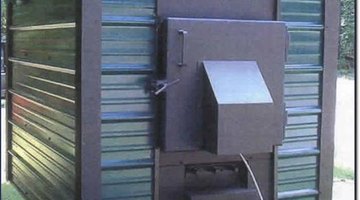How to Plumb in an Outdoor Wood Furnace
Plumbing your outdoor wood furnace into your existing home heating system is a relatively simple task if attention is paid to your specific system and its heating needs. Wood furnaces heat homes in one of several ways, but the most popular are water heat exchange, heated air and heated oil. In the case of heated water and heated oil, cool liquid is circulated from the house, out to the furnace where it is heated. It is then pumped back to the house and through a heat exchanger (this looks and acts like a radiator) that warms the floors or walls of the house.
In the case of heated air, cool air is circulated from the outside, to the wood furnace where it is heated. It is then circulated to the house and blown out vents via a fan system.
Explore the basics of plumbing in any type of wood furnace into your home's existing heating system.

-
Determine the type of heating system you have now: forced air or heated liquid (water or oil). Having purchased the correct type of furnace for your heating type, disconnect your old furnace from the ductwork or plumbing.
-
Set your outdoor furnace up in the appropriate location on your property and dig a trench from your furnace to your house. You will be laying the plumbing or ductwork in here, so make sure it is the appropriate depth and width.
-
Connect ductwork or plumbing to the furnace and make sure all of your junctions are tight. Run the ductwork or plumbing from your furnace to the house in the trench. Fill the trench in over top of the plumbing or ductwork. The piping or ductwork should be covered with insulation as it is specific to an outdoor installation.
-
In the house, run ductwork or plumbing from the location of your old furnace to the location where you will be tying in your new ductwork or plumbing. Connect this junction, making sure that all of your connections are tight and you insulate around the area where the new ductwork or plumbing is to prevent drafts.
-
If you are using a liquid heating system (oil or water), you should now prime the system by pumping oil or water into the plumbing until you know it is full and free of air pockets. This is accomplished by running the pump (included in the furnace assembly) while liquid is pushed into the pipes. When liquid comes out of the "return" plumbing heading toward the furnace, your system is full.
-
Start up your furnace and check for leaks by examining all of the connections in the ductwork or plumbing. Turn the fan on if you are using a forced air system and check to see if each register is receiving the same air pressure. If not, adjust the register flaps and internal duct baffles to achieve equal air pressure.
Resources
Tips
- Many contractors can quickly and inexpensively install a new outdoor furnace system. This may be a better option if winter is fast approaching or your HVAC skills are not very advanced.
Warnings
- Wear gloves and goggles when installing ductwork as the metal edges can be quite sharp. Also, be careful when priming liquid heating systems, as the liquid can be extremely hot even after the first pass through the system.
Photo Credits
- www.alternateheatingsystems.com
More Articles



